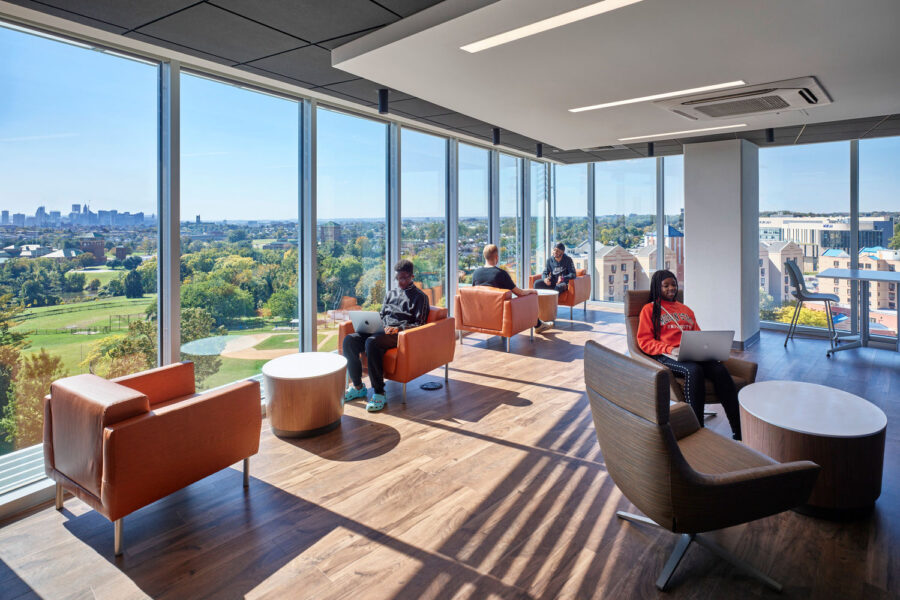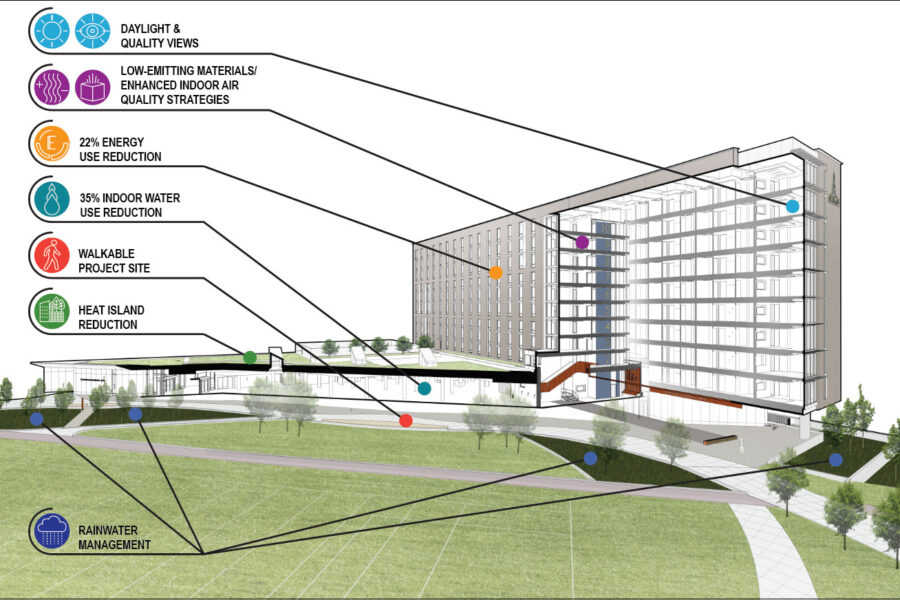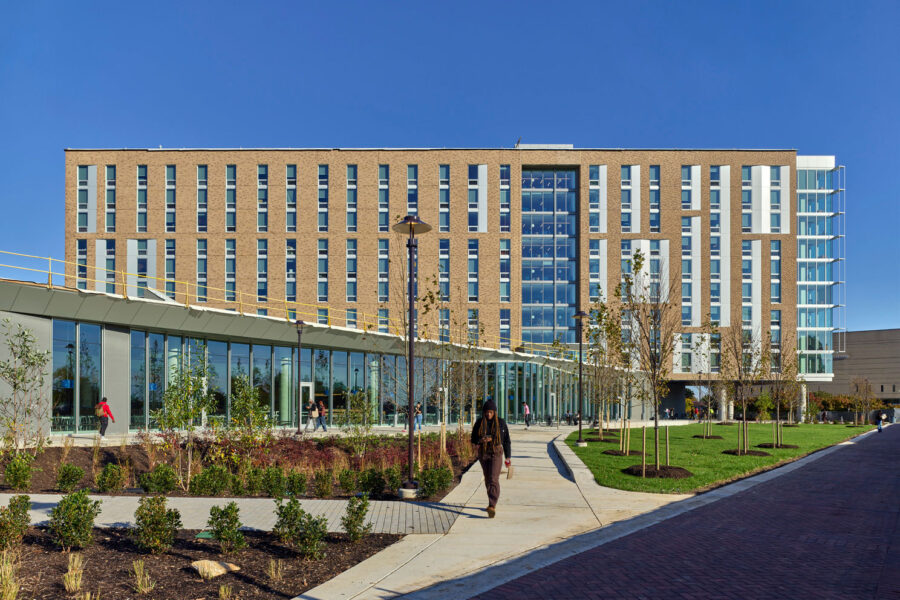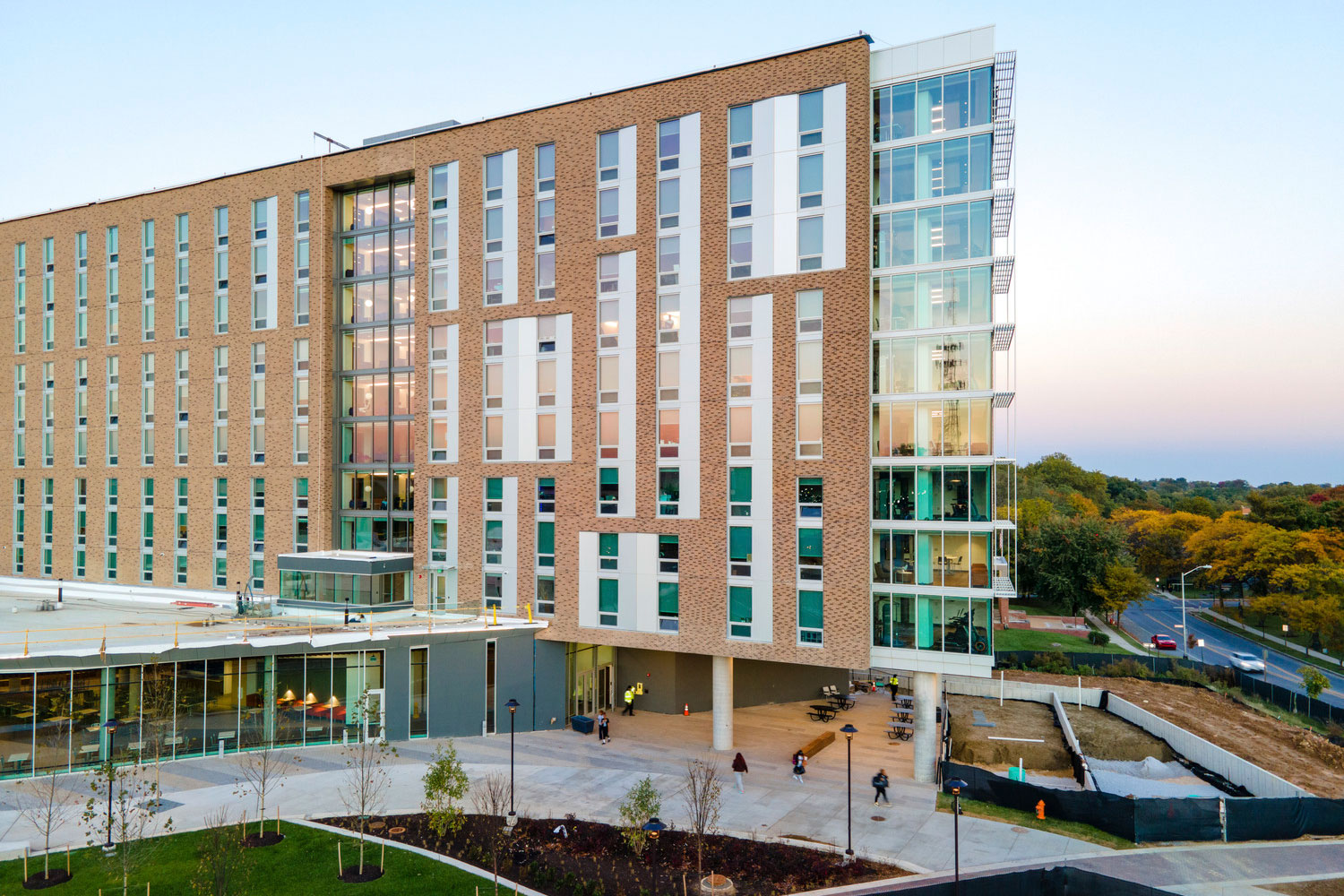Story at a glance:
- Hord Coplan Macht and Moody Nolan designed Thurgood Marshall Hall with a mix of semi-suite and apartment-style housing.
- The project emphasizes healthy and sustainable building materials, with a focus on improved indoor air quality.
- Student focus groups helped to inform the design, revealing a need for rich amenities to support students’ mental and physical health.
Over the past several years Morgan State University, a historically Black university and Maryland’s preeminent urban public research university, has deployed a strategic plan with a primary goal of increasing recruitment and improving retention of students on campus. The university aims to harness a welcoming, comfortable community where students can live and enjoy the many benefits of campus living while increasing sustainable elements and practices across campus.
In 2020 the university tapped our teams at Hord Coplan Macht and Moody Nolan to design more than 200,000 square feet of livable space for students, including a new residence hall and dining facility with the intent to curate a home-like and high-end experience for the student population. Officially opening its doors this in fall 2022, Thurgood Marshall Hall provides a mix of semi-suite and apartment-style housing, including more than 660 beds for undergraduate and graduate students, as well as a 40,000 square foot dining facility which opened in January.
The project honors and pays tribute to Baltimore native and Associate Justice of the Supreme Court Thurgood Marshall with unique murals. The new facility, built upon a former recreation field and the former Thurgood Marshall Apartments, forms the campus hub for student activity and enhances the community culture by creating a vibrant and robust space for gathering and living. The residence hall, complete with 24-hour dining and carefully cultivated individual and group study areas, forms a live, dine, learn nexus for students.
As a local Baltimore-based firm and with our longstanding relationship with the university, Hord Coplan Macht was the perfect match for the project. As the largest African-American owned and operated architecture firm in the country, Moody Nolan was uniquely positioned for this project, as the team brings an authentic understanding of the cultural, social, and economic impacts of each space they create. Moody Nolan has worked with over 30 historically Black Colleges and Universities (HBCUs) to elevate the character and quality of campuses, while creating a first-class college experience. The resulting project enforces a sense of community, where students can make friends, relax, and study. Our teams partnered to create an organized, intentional space designed to play a vital role in students’ academic success.
Bring the Students Home

Floor-to-ceiling windows provide natural lighting with views of downtown Baltimore. Photo courtesy of Hord Coplan Macht
Going into the project, both of our teams thoroughly researched the existing structures on campus, the demographic in which they were designing for, and the overall goals of the university. We unveiled the need for a centralized, community-driven student living facility for first- and second-year students to experience all that college has to offer while enjoying a sustainable, high-end living experience.
The design process began during the early days of the pandemic, which influenced some of the planning––particularly as it relates to health-focused additions. The air filtration system was upgraded to help keep the students healthy. All the interior finishes selected are made from low-emitting materials, helping to further improve the overall air quality. We also looked at high touchpoint areas and sought out more sanitary options, like a foot-activated call button for each elevator.
Other health-conscious features included skylights strategically placed throughout the building to capture as much natural light as possible. Floor-to-ceiling windows were also incorporated, which not only bring in natural lighting but provide incredible views of downtown Baltimore and the surrounding areas.
Student Insight Informing Interior Design

Prolific court case murals found on each floor showcasing Thurgood Marshall’s legacy. Photo courtesy of Hord Coplan Macht
To inform the interior design, Moody Nolan conducted student focus groups to fully understand what they wanted in each space to support their education and lifestyle. Moody Nolan met with more than 50 students, staff, and faculty, representing 12 interest groups on campus, including residence life and housing, auxiliary services, student affairs, multiculturalism and diversity, and student government.
The findings revealed a need for the new facility to address student success beyond a place to sleep and eat. It was a high priority to have rich amenities to support students’ mental and physical health. Both teams prioritized a variety of spaces within the overall design to promote wellness. The spaces included fitness studios, a counseling center, and a tutoring center to further promote student success.
Students and stakeholders were empowered throughout the engagement process. The team presented example unit configurations with the focus groups and openly discussed the pros and cons of each scenario. Ultimately the semi-suite, with two bedrooms for four students, was the preferred unit. The unit mix also offered apartment-style and single options for students. Community building opportunities were included on every floor with a unique dispersion of destinations for lounging, studying, and working out.
Moody Nolan also identified that the dining space should accommodate more than just food service. It was discovered that students wanted a holistic approach to their dining experience that centered on well-being—one that connected healthy options, grab-and-go, and varied meal plans with their desire to informally study and collaborate around food. The vision produced a model outcome of creating a healthy dining experience that prioritized student wellness.
The interior materials help to support this experience as well. The flooring features organic patterns and textures that mimic biophilic elements. Changes in color and pattern were used effectively to support wayfinding. Moody Nolan used contrasting light and dark flooring in the dining hall to break up the large space as well as the zone areas for private versus public seating groups. In the residential corridors, two Green Label Plus–certified carpets work together harmoniously to highlight unit entries.
The use of rapidly renewable, tackable wallcovering outside units helps to promote personalization of the space and offers better acoustics. Acoustics were a vital part of the overall design of the building, especially in the design of the dining hall. Moody Nolan created an intriguing design using lay-in ceiling panels alongside baffles that have a wooden texture. Soffits follow the flooring patterns below to tie the two elements together and further define the zones of seating below.
As students walk into the building, vestibules with walk-off carpet tiles help to capture particulates from the outside environment, further contributing to the cleanliness of the space. The product itself is another CRI Green Label Plus-certified product as well as a mindful MATERIAL.
Within the residential interior Hord Coplan Macht and Moody Nolan also incorporated environmental graphics of Thurgood Marshall to convey the story of his legacy and accomplishments. Each floor features a mural highlighting a significant court case which defined not only his life, but history as a whole. Further establishing the university’s commitment to the success of their students, a Morgan State University art program student painted a mural on the ground floor showcasing Marshall through various periods of his life and career.
Site Planning

Image courtesy of Hord Coplan Macht
Looking beyond the interior elements, we also wanted to focus on providing dedicated outdoor spaces, which we’ve found over the course of the pandemic are essential for students’ health and wellness. Our team at Hord Coplan Macht was responsible for the landscape and hardscape design around the building. Seeking to provide a home away from home for the students, we opted for a variety of outdoor spaces to fit every need, including an entry plaza with bench seating, an outdoor dining area, dedicated lounge spaces with charging stations for laptops and phones, and a sloped lawn space. We also designed a green roof amassing more than 20,000 square feet, which contributes to reducing storm water quantity and improving the quality of the water. A selection of water conserving plumbing fixtures were also implemented within the building to contribute to a 35% reduction in indoor water use, further contributing to the overall sustainability efforts across the campus.
When planning the overall landscaping, the largest obstacle we faced was working with the stormwater management constraints and trying to find creative solutions to meet local mandates. We were able to achieve this by placing various water management sites across the site, which seamlessly blended with the landscape. To provide additional lounge seating and outdoor gathering areas, strategically placed benches were included along the rainwater management areas.
Looking Toward the Future

Photo courtesy of Hord Coplan Macht
The overall project has been a success among students thus far, and we’re looking forward to continuing to improve the lifestyle for students and further developing our relationship with the university with our next phase. Currently under construction, our teams have designed an additional 600-bed high-rise building, situated next to the dining facility. The next phase is slated for completion in August 2024.
Project Details
Project: Thurgood Marshall Hall, Morgan State University
Location: Baltimore, MD
Completion: August 2022
Size: 222,000 square feet
Architects: Hord Coplan Macht, Moody Nolan
Contractor: Gilbane Building Company
Landscape Architect: Hord Coplan Macht
Developer: Maryland Economic Development Corporation
Architect Yanitza Brongers-Marrero of Moody Nolan contributed to this article.

